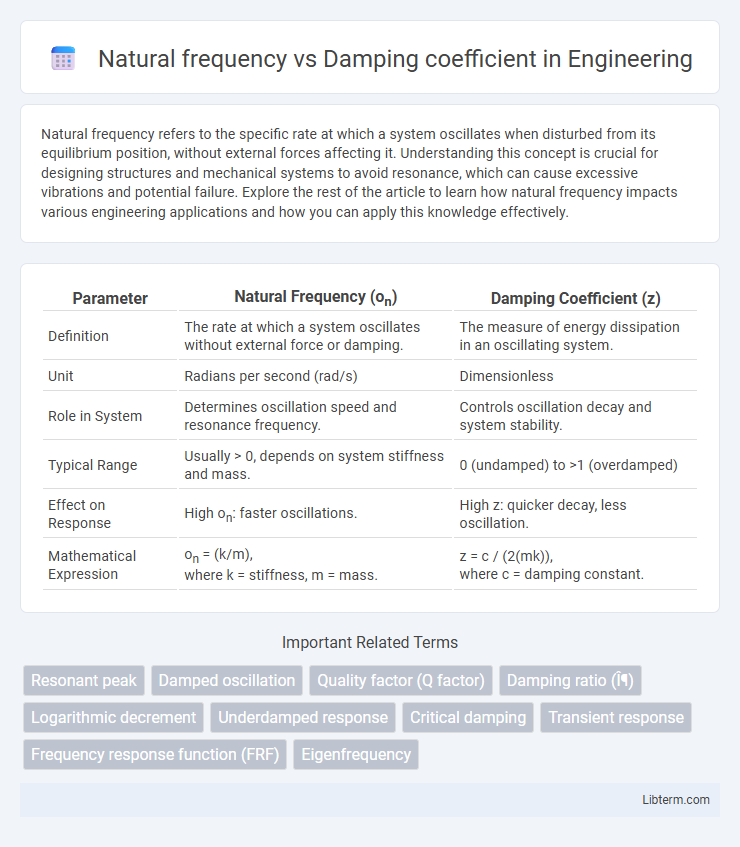Natural frequency refers to the specific rate at which a system oscillates when disturbed from its equilibrium position, without external forces affecting it. Understanding this concept is crucial for designing structures and mechanical systems to avoid resonance, which can cause excessive vibrations and potential failure. Explore the rest of the article to learn how natural frequency impacts various engineering applications and how you can apply this knowledge effectively.
Table of Comparison
| Parameter | Natural Frequency (on) | Damping Coefficient (z) |
|---|---|---|
| Definition | The rate at which a system oscillates without external force or damping. | The measure of energy dissipation in an oscillating system. |
| Unit | Radians per second (rad/s) | Dimensionless |
| Role in System | Determines oscillation speed and resonance frequency. | Controls oscillation decay and system stability. |
| Typical Range | Usually > 0, depends on system stiffness and mass. | 0 (undamped) to >1 (overdamped) |
| Effect on Response | High on: faster oscillations. | High z: quicker decay, less oscillation. |
| Mathematical Expression |
on = (k/m), where k = stiffness, m = mass. |
z = c / (2(mk)), where c = damping constant. |
Introduction to Natural Frequency and Damping Coefficient
Natural frequency refers to the rate at which a system oscillates in the absence of external forces or damping, typically measured in Hertz (Hz). The damping coefficient quantifies the resistance that reduces the amplitude of oscillations, expressed in units like kg/s or N*s/m. Understanding the interplay between natural frequency and damping coefficient is essential for analyzing the dynamic behavior of mechanical and structural systems.
Defining Natural Frequency
Natural frequency refers to the rate at which a system oscillates when disturbed from its equilibrium position without external force or damping effects. It is a fundamental property determined by the system's physical parameters such as mass and stiffness. The damping coefficient, in contrast, quantifies the energy dissipation within the system, influencing how quickly oscillations diminish but not the intrinsic natural frequency itself.
Understanding Damping Coefficient
The damping coefficient measures the rate at which oscillations decrease in a vibrating system, directly influencing the amplitude and decay time of natural frequency oscillations. A higher damping coefficient results in faster energy dissipation, reducing the system's oscillatory response and preventing prolonged vibrations at its natural frequency. Accurate understanding of the damping coefficient is essential for designing systems that require controlled vibration behavior, such as automotive suspensions and structural engineering applications.
The Mathematical Relationship Between Natural Frequency and Damping
The natural frequency (o_n) represents the frequency at which a system oscillates without damping, while the damping coefficient (z) quantifies the effect of energy dissipation on oscillations. The damped natural frequency (o_d), describing the actual oscillation frequency in a damped system, is mathematically expressed as o_d = o_n(1 - z2), highlighting the inverse relationship between damping and oscillation frequency. This equation demonstrates that as the damping coefficient increases, the damped natural frequency decreases, impacting system response and stability.
Types of Damping in Mechanical Systems
Natural frequency characterizes the inherent vibration rate of a mechanical system without external forces, while the damping coefficient quantifies the energy dissipation during oscillations. Types of damping in mechanical systems include viscous damping, where resistance is proportional to velocity; Coulomb damping, characterized by constant frictional force; and structural or material damping caused by internal material hysteresis. Understanding these damping types is essential for controlling vibrational behavior and enhancing system stability and longevity.
Effects of Damping Coefficient on System Response
The damping coefficient significantly influences the system's natural frequency by reducing the amplitude of oscillations and altering the rate at which energy dissipates during vibrations. Higher damping coefficients lead to faster attenuation of oscillatory motion, minimizing resonance effects and improving system stability. In mechanical and structural systems, critical or over-damped conditions prevent oscillations, whereas under-damped systems exhibit sustained vibrations influenced by the interplay between natural frequency and damping.
Practical Examples: Real-World Applications
The natural frequency of a system determines its inherent vibration rate, while the damping coefficient measures how quickly oscillations diminish, both critical in automotive suspension design to balance ride comfort and stability. In building engineering, controlling the natural frequency of structures alongside optimized damping coefficients helps mitigate earthquake-induced vibrations, ensuring structural integrity and occupant safety. Industrial machinery employs precise tuning of natural frequency and damping to minimize resonance, reducing wear and preventing mechanical failure during operation.
Measuring and Calculating Natural Frequency and Damping
Measuring natural frequency involves analyzing the time response of a system to an impulse or free vibration, typically using accelerometers or laser vibrometers to capture oscillation data. Calculating natural frequency uses the system's mass and stiffness parameters through the formula \( f_n = \frac{1}{2\pi} \sqrt{\frac{k}{m}} \), where \( k \) is stiffness and \( m \) is mass. Damping coefficient measurement depends on the logarithmic decrement method or half-power bandwidth approach, quantifying the rate at which oscillations decay, while calculation relies on the relationship between damping ratio, natural frequency, and critical damping.
Importance in Engineering and Design
Natural frequency determines the inherent oscillation rate of a system without external forces, crucial for predicting resonance conditions in mechanical and structural engineering. The damping coefficient quantifies energy dissipation during oscillations, directly influencing system stability and vibration control to prevent fatigue and failure. Optimizing both parameters ensures safe, efficient designs by mitigating resonance-induced damage and improving dynamic performance in engineering applications.
Conclusion: Balancing Natural Frequency and Damping in Systems
Balancing natural frequency and damping coefficient is crucial for optimizing system performance and stability. High natural frequency ensures rapid response, while appropriate damping prevents excessive oscillations and resonance-induced damage. Effective control of these parameters minimizes vibrations, enhancing longevity and reliability in mechanical and structural systems.
Natural frequency Infographic

 libterm.com
libterm.com